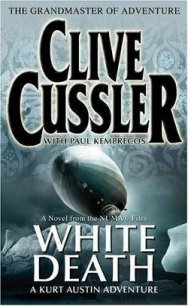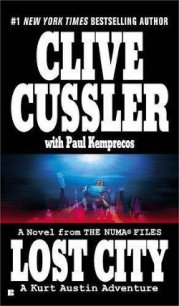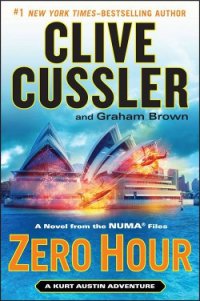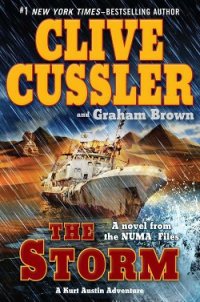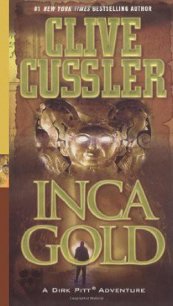The Navigator - Cussler Clive (читаем книги онлайн бесплатно полностью .TXT) 📗
“What are those dark areas on the statue?” Baltazar asked.
“The statue was made with the lost wax process,” Defoe said. “The artist made a clay form, which was encased in wax, then clay again. The X-ray shows the channels and vents that were drilled in the outer shell to allow wax and gas to escape and molten metal to be poured in. The statue was fabricated in pieces, so we’re also looking at rivet points and hammer marks.”
“All very interesting,” Baltazar said. “But what is inside the statue?”
“The X-ray shows nothing behind the bronze exterior except for a hollow space,” Gray answered.
“What about the exterior?”
“A lot more promising.” Gray produced a slim remote control from his suit jacket and pointed it at the screen. The ghostly figure disappeared. Filling the screen was a close-up of the statue’s face. “I’ll let Dr. Defoe deal with this area.”
Defoe squinted at the screen through round-framed glasses. “The damage makes it difficult to gauge the subject’s age, but, judging from the muscular body, he is probably in his twenties.”
“Forever young,” Baltazar observed in a rare poetic moment.
“The conical hat is similar to that we see in pictures and sculptures of Phoenician sailors. The beard and hair have me puzzled. The way they are layered denotes someone of upper-class Phoenician society, yet he is garbed in the kilt and sandals of a simple sailor.”
“Go on,” Baltazar said. There was no discernible change in his expression despite his growing excitement.
The image morphed into a close-up view of the pendant around the Navigator’s neck. “This pendant replicates a Phoenician coin design,” Defoe said. “The horse is the symbol for Phoenicia. The uprooted palm tree to its right denotes a colony. Here’s where things get intriguing.”
The red dot jumped to a semicircular space below the horse head and palm tree where there was a horizontal line of squiggles.
“Runes?” Baltazar said.
“That was the common assumption when figures like these were seen on the coins. However, none matched any known Phoenician script. The markings remained a puzzle for years. Then a geologist at MountHolyokeCollege named Mark McMenamin came up with a startling new theory. He submitted the symbols to computer enhancement, which I will do here.”
The symbols on the screen became sharper and more defined.
“This pattern looks familiar,” Baltazar said.
“Perhaps this will help.” The shapes on the screen were set off by familiar continental outlines.
Baltazar leaned forward. “Incredible. They’re continents!”
“That was McMenamin’s conclusion. As a geologist, he recognized the landmasses for what they are. You can make out the rectangular shape of the Iberian Peninsula projecting down at an angle from Europe, which with North Africa encloses the Mediterranean. That’s Asia off to the right. Those smaller symbols west of Europe could be the British Isles. North America is the landmass on the left. South America seems to be missing or absorbed into the northern continent. Computer enhancement can be subject to different interpretations. But if McMenamin is right, this pendant indicates the range and scope of Phoenician colonies.”
“A bloody map of the world,” Baltazar said with a grin.
“Not just any map of the world. The gold coins I mentioned were minted around 300 B.C. The bronze in this statue is about three thousand years old, making this the oldest world map we know of. More important, it indicates travel to the New World as early as 900 B.C., when the statue was made.”
Baltazar felt a rush of blood through his veins.
“I want to take a closer look at North America,” he said.
The enlarged symbol that appeared on the screen looked like an obese saguaro cactus. A pair of thick arms were upraised from a wide trunk.
Baltazar snorted. “You must admit that it takes a stretch of the imagination to see that amorphous blob as the North American continent.”
“Maybe this will help,” Defoe said. An outline of North America was superimposed over the symbol. “The trunk becomes the main continent. That’s Alaska off on the left and Newfoundland on the right.”
“Any evidence of trade routes between the Eastern and Western Hemispheres?”
“Not specifically. But that shouldn’t come as any surprise given the Phoenician penchant for secrecy, and the fact that ocean routes consisted of astronomical readings that could be committed to memory. But if we look at the compass in the statue’s hand,” he said with a flick of the remote, “we can deduce that east–west, west–east trade routes are suggested. The position of the statue relative to the north point of the compass rose indicates that he is looking toward the west.”
“Toward the Americas,” Baltazar said.
“Correct.”
“Can you pinpoint a landfall?”
Defoe shook his head. “This statue is the equivalent of the world maps you see in the airline magazines. Informative, but in no way useful to an airplane pilot.”
“They would have needed a more detailed chart when close to shore,” Baltazar pointed out.
“That’s right. Maps had limited value at sea. They would have needed a coastal pilot that showed the location of prominent points, so the travelers could check position. Directions rather than distance become paramount close to shore.”
“Is there any evidence of a coastal pilot?”
Defoe shook his head. “I have found nothing that denotes navigational positioning. I did find something else, however.”
The screen image changed once more. “This symbol was etched repeatedly in the sash that held up the sailor’s kilt.”
“It looks something like a boat,” Baltazar said. “Rough depictions of the bow and stern.”
“The symbol looked familiar to me. I remembered seeing it in a book by Anthony Saxon. He’s an amateur archaeologist and explorer who’s come up with some outlandish theories.”
“I know who Mr. Saxon is,” Baltazar said, in a tone that dripped with icicles.
“Saxon is a self-promoting showman, but he’s been around. He says this is the symbol for a ship of Tarshish. He’s found examples in both the Americas and the Middle East, thereby establishing a link between the two regions.”
“I’m not interested in half-baked theories put forth by fools,” Baltazar said. “Tell me if anything on this statue pinpoints a North American landfall.”
“The answer is yes and no.”
Baltazar glowered. “I’m a busy man, Dr. Defoe. I’m paying you a great deal for your expertise. Don’t waste my time with riddles.”
Defoe became uncomfortably aware of the menace behind Baltazar’s smooth veneer. “Sorry,” he said. “I’ll show you what I mean.” He clicked the remote and the screen displayed a faint network of curving lines. “We think this is a topographical map.”
“Where on the statue did you find it?”
The camera lens drew back to reveal the cat that formed part of the statue’s base.
“You’re telling me the information I want was written on the side of a cat?”
“It’s not really that far-fetched. The Egyptians regarded felines as sacred, and the Phoenicians drew upon Egypt for their religious themes.”
“What did your computer enhancement show?”
“This is the computer enhancement.”
“I see nothing.”
“It’s the best we could do. The surface was worn away for the most part except for a small area which you see here. We’ll include what we’ve found in the final report, but, for all intents and purposes, any information engraved in the metal is gone forever.”
“I’ll have to concur,” Dr. Gray said. “No technology on earth can re-create that which is no longer there.”
If not here, elsewhere, Baltazar thought.
“This lost wax process you mentioned. Could it be used to create a duplicate of this statue?”
“It would be no trouble if the sculptor used the indirect process, which forms the wax around a finely defined core.”
